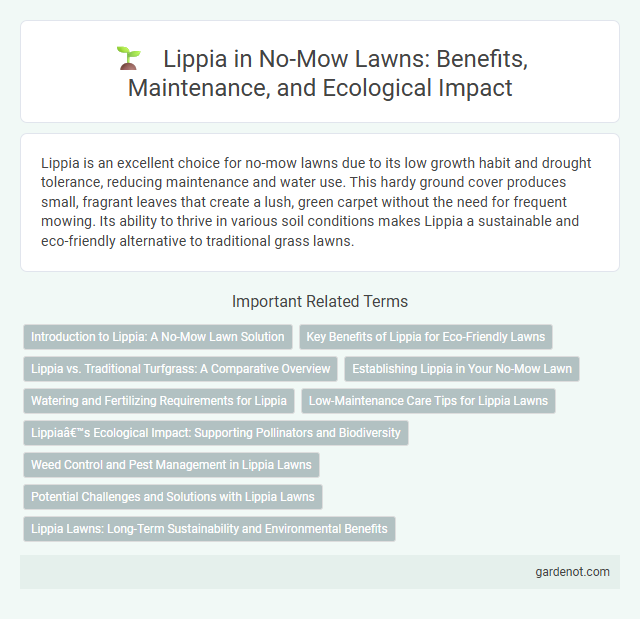Lippia is an excellent choice for no-mow lawns due to its low growth habit and drought tolerance, reducing maintenance and water use. This hardy ground cover produces small, fragrant leaves that create a lush, green carpet without the need for frequent mowing. Its ability to thrive in various soil conditions makes Lippia a sustainable and eco-friendly alternative to traditional grass lawns.
Introduction to Lippia: A No-Mow Lawn Solution
Lippia is an ideal no-mow lawn alternative known for its low maintenance and drought tolerance, thriving in various climates with minimal watering. This ground cover forms dense, green mats that suppress weeds while providing a soft texture suitable for foot traffic. Its fast growth rate and ability to stay short eliminate the need for regular mowing, making it perfect for sustainable landscaping.
Key Benefits of Lippia for Eco-Friendly Lawns
Lippia offers drought resistance and low maintenance, making it ideal for eco-friendly lawns by reducing water usage and eliminating the need for frequent mowing. Its dense growth suppresses weeds naturally, enhancing biodiversity and soil health without chemical interventions. Lippia also supports pollinators, contributing to a balanced ecosystem in sustainable lawn management.
Lippia vs. Traditional Turfgrass: A Comparative Overview
Lippia offers a sustainable alternative to traditional turfgrass by requiring significantly less water and maintenance while providing dense ground cover and natural pest resistance. Unlike traditional turfgrass, which often demands frequent mowing and high fertilizer inputs, Lippia adapts well to drought conditions and improves soil health by reducing erosion. This low-maintenance plant supports biodiversity and enhances landscape aesthetics without the environmental drawbacks associated with conventional lawns.
Establishing Lippia in Your No-Mow Lawn
Lippia thrives in no-mow lawns due to its low-growing, spreading habit, which minimizes maintenance and enhances soil coverage. Establishing Lippia requires well-drained soil and full sun exposure to promote vigorous growth and dense ground coverage. Regular watering during initial establishment supports root development, enabling Lippia to outcompete weeds and create a lush, self-sustaining no-mow lawn.
Watering and Fertilizing Requirements for Lippia
Lippia thrives in well-drained soil with moderate watering, requiring infrequent irrigation once established to prevent overwatering and root rot. It benefits from occasional fertilizing using a balanced, slow-release fertilizer during the growing season to promote healthy foliage and flowering. Proper watering and fertilizing practices ensure Lippia remains a hardy, low-maintenance choice for no-mow lawn alternatives.
Low-Maintenance Care Tips for Lippia Lawns
Lippia thrives in well-drained soil with full sun exposure, making it an ideal choice for no-mow lawns. Regular but moderate watering supports its drought tolerance while preventing root rot, and minimal fertilization during the growing season enhances its vibrant green appearance. Periodic trimming controls growth without the need for frequent mowing, ensuring a lush, low-maintenance ground cover that reduces lawn care efforts.
Lippia’s Ecological Impact: Supporting Pollinators and Biodiversity
Lippia, a low-maintenance ground cover ideal for no-mow lawns, significantly enhances ecological balance by attracting pollinators such as bees and butterflies. Its dense foliage provides habitat and food resources, boosting local biodiversity and supporting ecosystem health. Planting Lippia contributes to sustainable landscaping by reducing lawn maintenance and promoting pollinator populations.
Weed Control and Pest Management in Lippia Lawns
Lippia lawns naturally suppress weed growth due to their dense, low-growing foliage, which limits sunlight penetration to the soil and inhibits weed seed germination. The plant's essential oils possess insect-repellent properties, reducing pest populations without the need for chemical treatments. Effective weed control and pest management in Lippia lawns promote a sustainable, low-maintenance turf alternative.
Potential Challenges and Solutions with Lippia Lawns
Lippia lawns offer drought tolerance and low maintenance, yet they face potential challenges such as susceptibility to pest infestations and uneven growth patterns. Proper integrated pest management and regular thinning techniques improve lawn health and aesthetic appeal. Adjusting irrigation schedules and soil nutrients further enhances Lippia establishment and resilience.
Lippia Lawns: Long-Term Sustainability and Environmental Benefits
Lippia lawns provide long-term sustainability by requiring minimal water and no mowing, significantly reducing carbon emissions compared to traditional grass lawns. Their deep root systems enhance soil health, improve erosion control, and support local biodiversity by providing habitat for pollinators. These hardy, drought-resistant plants also reduce the need for fertilizers and pesticides, promoting an eco-friendly and cost-effective lawn solution.
Lippia Infographic

 gardenot.com
gardenot.com